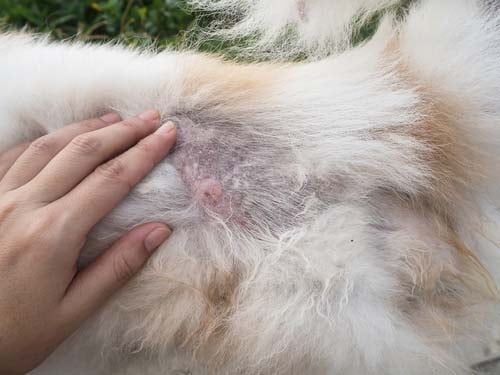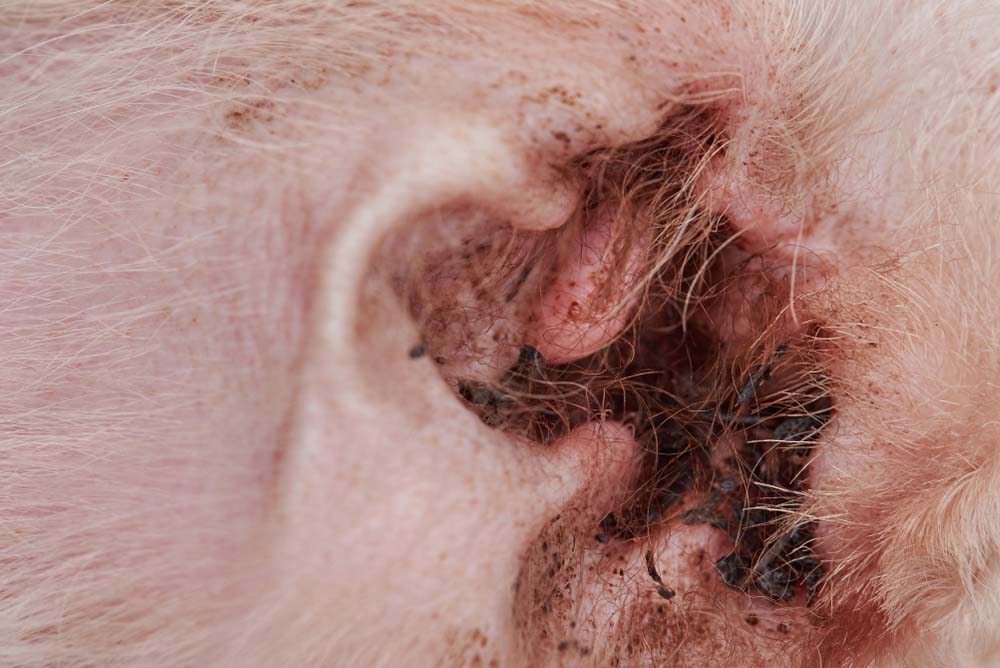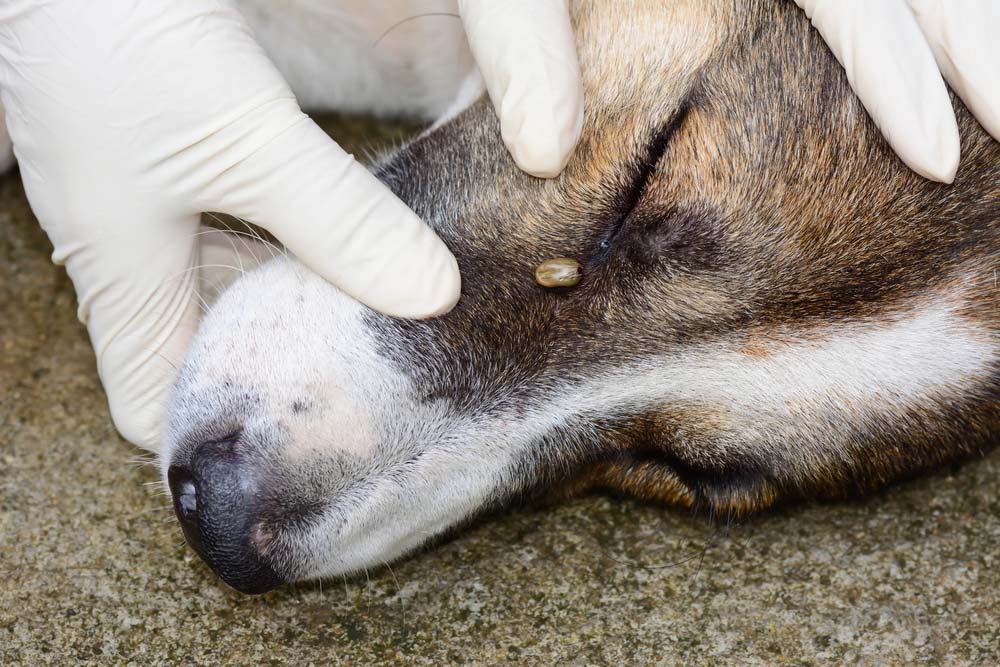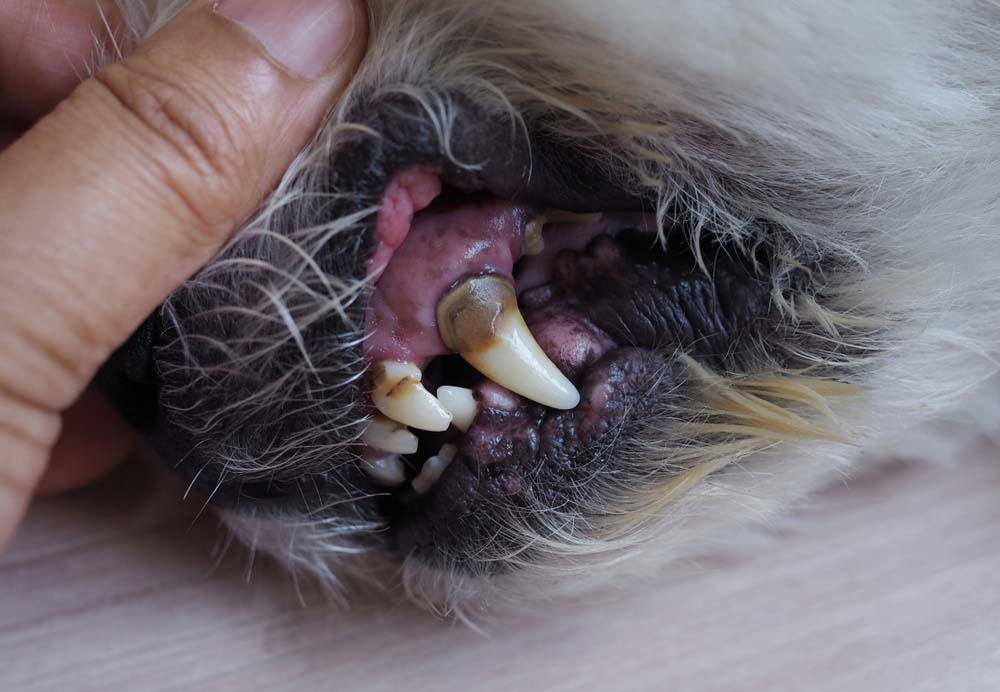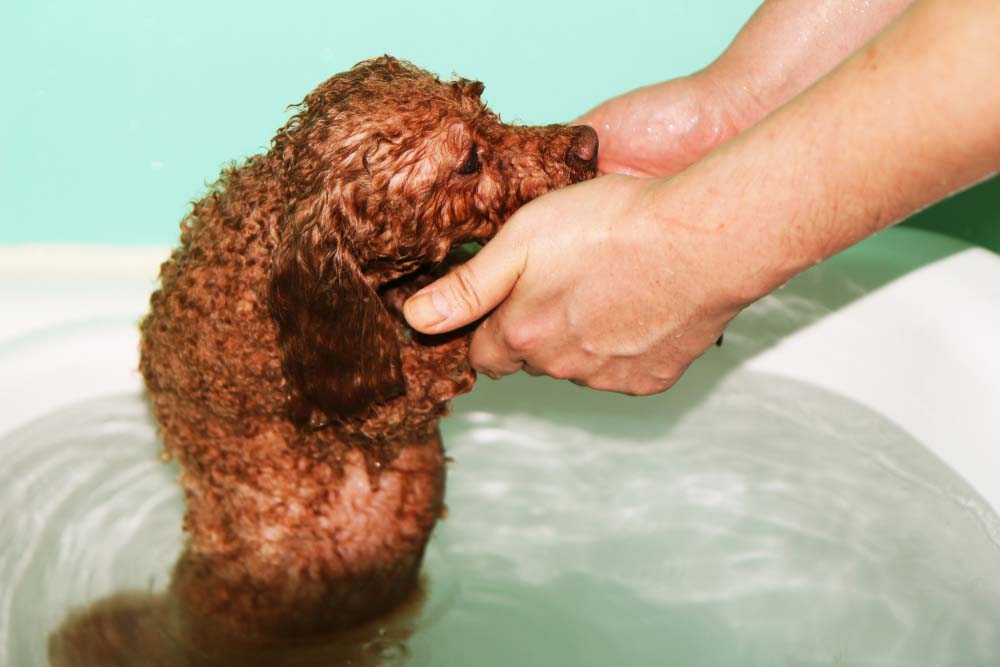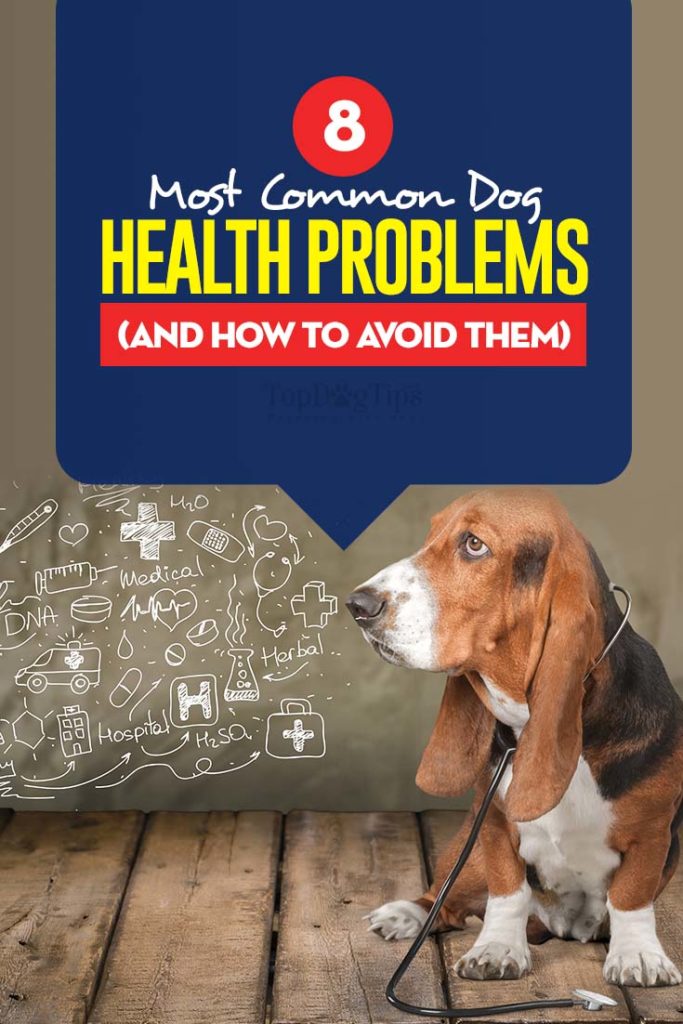Table of Contents
Veterinary medicine has made a lot of progress in predicting future health problems in dogs, and veterinarians (and owners) are now much more effective at treating them.
As a pet owner, knowing what the most common dog health issues are can help you avoid them, recognize them early and treat them in your pooch effectively.
Many dog breeds are genetically predisposed to certain health conditions, such as a higher likelihood of arthritis or hip dysplasia, and owners of those breeds should be prepared.
However, some dog health problems are statistically more common among all breeds and scientific literature shows that the below nine dog health issues with pictures are what majority of pet owners will likely have to deal sooner or later.
9 Common Health Issues in Dogs
1. Skin Issues
Skin problems in dogs are probably the most common health problem pet owners face, which is not surprising since there are nearly 200 different skin conditions your canine can suffer from.
Studies report a 15% to 25% prevalence of canine skin conditions.
The usual symptoms of skin disorders in dogs include scratching, chewing, and licking of the skin, as well as visual signs. The dog's skin may appear inflamed, red, flaky, or scaly.
Anything unusual in the way your dog’s skin looks and any abnormalities, such as rashes or bumps, can be a sign of a skin disease.
Skin problems in dogs can be caused by different things, but statistically, they are more likely to be caused by allergies and parasites.
Food and airborne allergies, and parasites like mites and fleas are the most usual culprits. Bacterial and yeast infections can also lead to a variety of canine skin problems.
How to Avoid It:
Using a high-quality vet recommended shampoo can help your dog avoid skin problems in the first place.
Regular hygiene and grooming will definitely help as well.
Adding omega-3 fatty acids in the form of supplements or different diet (oily fish) is good for dog’s skin and coat health and appearance.
How to Fix It:
Treating skin problem on dogs itself is usually done with topical creams, ointments and oral medication.
Due to there being over 160 different skin conditions, their severity and treatment plans vary greatly.
However, it is also important to always treat the underlying cause. Take your dog to the vet to get the right diagnosis and therapy plan.
2. Ear Infections
While many pet owners may not think so at first, ear infections are the second most common dog health issue that can often be spotted when pets scratch their ears or shake their heads, and ear diseases will vary in their structure and necessary treatments.
Other typical symptoms include ear discharge or debris. Ear problems and especially ear infections in dogs are usually itchy and sometimes painful for your pet.
They can be caused by bacteria, yeast, allergies or parasites. Some ear infections are simply caused by moisture in the dog's ear canal due to swimming, bathing or grooming.
How to Avoid It:
Check your dog’s ears often to spot any problems early, and clean your dog’s ears regularly.
When you bathe your pooch or take him swimming, make sure to dry his ears properly to avoid moisture build-up (and do not spray water directly into the dog's ears).
If you know that your dog has allergies, keep him away from allergens.
How to Fix It:
Treating ear infections in dogs usually starts with a detailed ear cleaning.
Because in most cases this is not a big deal, you can do this yourself with a cotton ball and a cleaning solution. Avoid using Q-Tip swabs since they often push any debris further in.
Don’t use alcohol solutions since they can irritate the inflamed skin. As this guide explains, in more severe cases, the best option is to let your vet do this.
After cleaning, the underlying cause (if any) also needs to be addressed with a proper treatment.
3. Internal Parasites
Parasites are all around your dog. There are internal parasites, like intestinal worms and heartworms, as well as external parasites, like ticks and fleas.
There are many types of internal parasites – hookworms, roundworms, heartworms, tapeworms, and whipworms.
The severity of this problem varies, but it's important to deal with it as soon as possible.
Internal parasites are one of the most common dog health issues that can be especially dangerous for puppies.
For example, hookworms can lead to anemia, and roundworms can cause poor growth and development.
The most common symptoms of worms in dogs include coughing, diarrhea, vomiting, weight loss, skin changes and presence of worms in fecal matter or fur.
How to Avoid It:
All pet owners must use a dog dewormer first and foremost. Then, keep your dog’s living area clean.
Remove your dog’s feces daily from your backyard or sandbox, and wash the dog's bedding once a week.
If your dog has a kennel or a crate where he spends his time, clean it regularly as well. Keep your home and backyard clean and deal with any mice or rats infestation promptly.
Snails and slugs can also infect your pooch with internal parasites, so keep them at bay.
How to Fix It:
The therapy will depend on the type of worms, but it will always consist of medication. The strength of that medication will depend on what condition your pet is in.
If you fail to prevent worms, definitely take your dog to the vet to get the proper treatment.
There are also home remedies you can use to speed up the deworming process, but those should only be used alongside anything else your veterinarian recommends.
4. External Parasites
The most infamous external parasites that dogs have are fleas and ticks, but different types of mites like ear mites and mange mites are also common among dogs.
For example, the prevalence of Demodex mites (the cause of mange in dogs) alone is at around 5%, and that's not accounting any other mite types or external parasites.
These parasites may be related to many other common dog health problems mentioned on this list.
Some parasites like ticks are clearly visible and ready to be removed, but you should also pay attention to symptoms like scratching, licking or biting of the skin or coat.
Certain parasites can only be found through observation of such symptoms.
How to Avoid It:
If your dog spends a lot of time outdoors, avoiding ticks and fleas is basically impossible.
Using preventive products is a good way to minimize the risk but you should consult your vet before you use them since there are many different options available and not all of them might be suitable for your dog or the environment you're in.
Always keep your yard clean and tidy and your lawn and bushes trimmed.
Keep your dog inside most of the day during the tick season (it starts in Summer, but adult ticks are particularly active in September).
Don't forget that even in cold winter months, dogs can still get ticks and fleas.
Check your dog’s fur often for signs of external parasites so you can deal with them promptly if they appear and prevent other dog health issues.
How to Fix It:
Due to a huge variety of external parasites, their treatment varies greatly, and it's crucial to discuss this with your vet.
Most commonly, when your dog has external parasites, there are many over-the-counter spot-on medications and topical creams you can use. You can also use oral medication.
Use medicated shampoos that contain antibacterial ingredients to kill ticks on contact.
5. Stomach Problems (Gastrointestinal Disorders)
Gastrointestinal (GI) disorders affect a dog's stomach and intestines and cause pain and other problems, and it's a common dog health issue that can either be fairly easily treatable and nearly harmless, or it can become an emergency situation where prompt treatment is necessary to save a dog's life.
Some of the typical symptoms of stomach problems and GI disorders in dogs include diarrhea or constipation, vomiting, flatulence, regurgitation, and weakness.
Diarrhea and vomiting can quickly lead to dehydration, and you must react fast and take your dog to the vet to determine the cause.
How to Avoid It:
The best way to ensure your dog has a good digestive health is a well-balanced diet and species appropriate nutrition.
This means choosing either top dog foods that you buy in the store or cooking your own homemade dog food meals that contain all the nutrients your pooch needs.
That includes proteins, carbs, fibers, vitamins and minerals.
Avoid impulse feeding your dog human food (table scraps).
You can use probiotics to increase the number of good bacteria in your dog’s gut, which helps the dog's stomach process foods better and more efficiently.
How to Fix It:
Since there are many possible GI disorders your dog can suffer from (and different causes of it), it is very important to get the right diagnosis first and then start the treatment.
A number of other dog health issues may be caused by GI disorders or stomach-related problems due to improper nutrient absorption.
Diet changes are almost always necessary, such as switching to foods for GI problems that will irritate your dog's stomach less, and the use of oral medication prescribed by your vet or certain supplements may also help.
6. Urinary Tract Infections (UTI)
Another common dog health issue that aren't quickly noticed by pet owners are urinary tract infections (UTI).
This condition can be caused by parasites, bacteria or fungi in the urinary tract of the dog, and occasionally by diet. The prevalence of UTI in dogs varies from 15% to 27%.
UTIs in dogs often lead to bloody urination, increased frequency of urination, urgency, and inappropriate urination.
Painful urination is the most typical symptom, so take your pup to the vet if you hear him whining or whimpering before, during or after urination.
How to Avoid It:
Encourage (through regular walks) your dog to eliminate himself regularly. Urine that sits in the bladder for too long can help bacteria grow. Keep your dog hydrated and provide clean drinking water for him at all times.
Pet fountains generally are more enticing for dogs to drink water. Don’t let his bowl go dry and clean it once a day before pouring new water.
If your dog is susceptible to urinary tract infections, ask your vet to prescribe special food or recommended homemade dog food recipes.
How to Fix It:
Other than home UTI remedies, the most common (and far more effective) treatment for UTI in dogs is antibiotics. However, some home remedies like cranberries and blueberries, apple cider vinegar, or vitamin C tablets can also help, as was observed in research.
Increase your dog’s fluid intake to stimulate the elimination of bacteria from his urinary tract, and encourage your dog to drink even if he doesn't want to.
7. Dog Obesity
Obesity is the fastest growing health problem for dogs in the U.S. and has been for decades now.
In fact, according to Association for Pet Obesity Prevention, in 2017, 56% of all dogs in the US were overweight or obese.
Obesity can lead to many other serious dog health issues, such as diabetes, orthopedic problems, arthritis, and heart diseases.
How to Avoid It:
Among all the other mentioned dog health issues here, preventing obesity in dogs is the easiest and most common sense.
Make sure that your dog has a healthy, well-balanced diet and that he consumes no more calories than he needs.
Keep dog treats limited to no more than 10% of his daily caloric intake and avoid human foods. Exercise your dog regularly.
How to Fix It:
Proper diet and exercise are the only way to help your dog to lose weight. You can consult with your vet on the most effective diet plan and try some weight loss dog foods.
In general, diet rich in protein and fiber will be best for weight loss in dogs.
The most important thing is to reduce the caloric intake and increase physical activity, and do it gradually.
8. Canine Dental Problems
There is a variety of dental problems your dog can have in his lifetime, like loose teeth, broken teeth and different gum problems.
Dental issues are observed in dogs as early as 2 years of age and the prevalence goes up as high as 80%. The most common dog health issues related to dental care is periodontal disease (PD).
According to the American Veterinary Dental College, by three years of age, most dogs have some evidence of periodontal disease.
Inflamed gums, bad breath, plaque, and swollen jaws are symptoms of periodontal disease in dogs. This is also one of the more often ignored parts of dog care by pet owners, which results in severe symptoms.
How to Avoid It:
Good oral hygiene is the key to dental health.
Many pet owners ignore this part of dog care but crucial to brush your dog’s teeth regularly, at least a few times a week but preferably once a day to keep his teeth healthy.
Take your dog to the vet often to remove any plaque and tartar to prevent it from spreading further and causing periodontal disease.
Special bones and specific chew toys (or dental treats) can improve your dog’s dental health further when using them alongside regular brushing (and not instead of it).
How to Fix It:
There's a huge variety of dental problems in dogs, and they can cause different dog health issues, so treatment will depend on the specific issue.
If your dog has periodontal disease, professional dental cleaning is a necessary first step.
After that, you must brush your dog’s teeth daily. Use proven dental chews and foods to help with the cleaning and removing the plaque.
9. Arthritis
While arthritis is not among the most common dog health condition in pets of all ages, it is an extremely common condition in senior dogs.
In fact, majority of dogs will suffer from different stages of arthritis as they age since this condition is a general term for abnormal changes in a dog's joint.
Recognizing arthritis symptoms early can help you deal with the problem better, so look for signs like decreased activity and aversion to it, mobility changes, weight gain, and touch avoidance.
How to Avoid It:
Since joint problems are a natural part of the aging process in both dogs and humans, you can’t really prevent them, but there are ways to slow down their progression.
Some precautions can be taken, however: avoid letting your dog jump off beds and cars too often (and use pet stairs instead), make sure the dog's diet is balanced and contains plenty of omega-3 fatty acids and probiotics, and avoid extra caloric intake.
Obesity can damage your dog’s joints and lead to arthritis, and an obese dog with arthritis will be much harder to care for and is likely to experience serious pain daily.
Exercise your dog regularly and take daily walks to keep his joints flexible and lubricated.
How to Fix It:
Fixing arthritis is not possible, but you can provide some relief for your dog.
In fact, there are many different options today, like pain-relieving medications, arthritis supplements and foods, physiotherapy, laser therapy, or even stem cell therapy.
Also, glucosamine and chondroitin sulfate, as well as similar nutritional supplements like vitamin E or omega-3 fatty acids from fish oil, are often used to treat dogs with arthritis.
Taking care of a dog is not easy and requires time, dedication, and effort.
Sadly, that is not always enough to avoid some of these most common dog health issues.
In such cases, quick reaction and proper diagnosis are crucial, so take your pooch to the vet as soon as you notice anything unusual in his behavior or appearance.
READ NEXT: 9 Common Dog Eye Problems (How to Prevent and Treat Them)
Want to share this?



